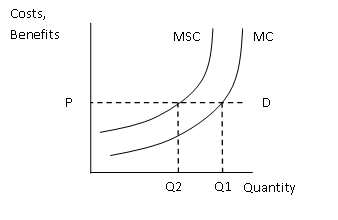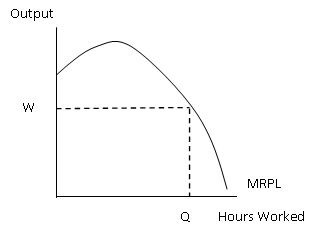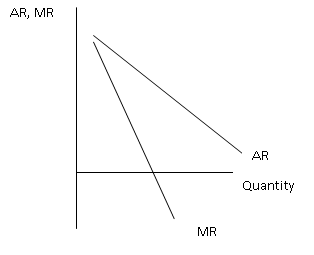Before
we look specifically at any of the three market structures in the title we
should take a closer look at revenue as this will be important in the analysis.
When price varies with output, which it does in all market structures bar
perfect competition, the demand curve is downwards sloping. Average revenue
equals (total revenue) / (quantity). This is the same as (price x quantity) /
quantity. Cancel out the two quantities and we're left with average revenue
being equal to price - hence it is equal to the demand curve.
So, the average revenue curve is sloping downwards
because it is equal to price. Why the position and shape of the marginal
revenue curve then? Well, as we know, marginal revenue is equal to the change
in total revenue divided by the change in quantity. If we substitute in price x
quantity for total revenue we are left with:
If we use the product rule to differentiate this (Google
this or find a text book, I'm not going to explain the pure math behind it) we're
left with marginal revenue being equal to:
The change in price over the change in quantity will give
us a negative figure, so what we're left with is Price + something negative.
Due to the "+ something negative" it will be falling below the AR
curve, hence its position on the diagram above.
The total revenue curve interacts nicely with the marginal
revenue curve we can see above. The total revenue curve increases at a
decreasing rate. Why? Well, because to sell more the firm has to lower its
price. Due to this, there will come a point when total revenue is maximised.
This will coincide with the quantity at which marginal revenue is equal to 0.
That quantity will be the revenue maximising quantity for the firm.
Now that we've understood the concept of revenue, let us
hone in on the specific market structures. We'll start with monopoly. In a
monopoly we have one firm that dominates the market. How do they do this? It is
largely due to the barriers to entry into the market. They could be any of the
following:
·
Economies of scale.
·
Legal restrictions.
·
Aggressive tactics.
·
Product differentiation.
...the list does go on. These all make it very difficult
for new firms to break into the market and pose any sort of competition/threat
to the existing monopoly firm. Graphically, a monopoly looks as follows:

They produce at the point MC = MR because this is where
profits are maximised. At this point there is a difference between average
costs and average revenue, revenue exceeds costs which means that the monopoly
is making a supernormal profit. All pretty obvious thus far. Monopoly is
probably the easiest of the market structures to master, all there is to
remember is that supernormal profits are made in the long and in the short run.
To the consumer a monopoly may seem to be a disadvantage - higher prices and
lower output compared to perfect competition. This is true, but it does have its
advantages. Firstly, supernormal profits fuel innovation which can lead to
better, cheaper products in the long run. Secondly, if the economies of scale
are big enough then through a monopoly some markets can exist that wouldn't be
possible if monopolies weren't allowed. This is in the case of a natural
monopoly.
Natural monopolies are markets that have very high, fixed
start-up costs. So high that it becomes
unprofitable if more than one firm try and provide the good/service. An example
would be the London Underground - massive start up costs in laying the
foundations of the network. So, if there were two firms in the market a loss
would always be made and therefore production wouldn't occur at all. See this
diagram below.
If there was two firms trying to run versions of the
Underground simultaneously then neither would be able to stay afloat only serving
half of the market each - whereas one firm serving the whole market means it is
affordable. With two firms, the demand curve above with slope down at twice the
rate meaning it is always below the long run average costs curve, meaning a
loss will be made. The scale of production that comes with a natural monopoly
means that costs can be lower and therefore the market price can be something
consumers will be willing to pay.
That's the low down on monopolies. Now to move onto
monopolistic competition. Do not get the two confused - similar names yet
totally different market structures. In a monopolistic market firms sell a
different variety or different brand of the same product. There are many firms
that all act independently of each other with freedom of entry and exit into
the market. There is symmetry in the market - new firms entering the market
effect all old firms equally.
1 = Firm demand. 2= Firm demand after new competitor
enters.
Each firm has a share of the whole industry, but can only
influence the price minimally, hence the inelastic demand curve for the firm.
Every time a new firm enters the industry all existing firms will see their
demand decrease and the influence they have on industry price fall. Every new
firm that enters moves the market closer to perfect competition.
A firms profit in the short run looks strikingly similar
to that of a monopoly. Supernormal profits are available. However, emphasis on
'short term'. Over the longer term more firms enter and prices are forced down.
The quantity each firm supplies is also forced down and supernormal profits are
quashed. Firms will keep entering until average costs equal average revenue, at
this point no more supernormal profit is available. We haven't entered perfect
competition because the demand curve/average revenue curve is sloping downwards
meaning price is not constant across all firms.
 |
|
On the left we have the firm in the short run. Supernormal
profit is made. The new firm enters and we move to the situation on the right
hand side. The firms individual demand has fallen, and thus its average revenue
and marginal revenue have fallen too. This means that the amount of profit that
is made has fallen. These firms will keep entering and this will keep happening
until supernormal profit is wiped out completely.
The model is all well and good taken at face value - but it
does have its limitations. In reality there is imperfect information about
profits and demand, it doesn't take into account the effect non-price
competition has and in reality it is difficult to identify an industry demand
curve. Bar all of these problems it does give us a fairly accurate
representation of a monopolistically competitive market. One problem with this
market type is because of the downwards sloping demand curve - production will
not take place at the lowest long run average cost. Therefore monopolistic
competition isn't as efficient as perfect competition.
The final type of market structure to analyse is that of an
oligopoly market. Oligopoly is when there are a few large, major players in an
industry. 3 or 4, for instance. There are significant barriers to entry and
firms are very interdependent. The firms have to look at the incentives to
compete with the other dominant firms and the incentives to collude with these
firms to determine their plan of action.
Now, to determine the total production of an oligopoly
market we have to run through a little story. We start with an industry with
one firm acting as a monopoly. The firms demand function is as follows: P = 200
- Q and its marginal costs are 0.From this, we can see that if quantity was 0
then price would be 200 and if price was 0 then the quantity would be 200. We
can use this to draw an initial demand curve.
We derive the marginal revenue curve by differentiating
total revenue. Total revenue = (200-Q) x Q, and that differentiated leaves us
with: MR = 200-2Q. Profit is maximised at MC=MR, and MC = 0, so therefore the
firm will produce 100 of the good. Half the market is supplied.
Now, the next part of the story is for a competitor to enter
the market. Firm B spots that there is unfulfilled demand, 100 of it, and
decides to enter the market. The demand curve for Firm B is going to be: P =
100 -Q. With that as the demand curve, and using the method in the paragraph
above, firm B works out it's marginal revenue curve to be: MR = 100 - 2Q. The
new market now looks like this:
Firm A is still supplying 100 of the market and now Firm B
has entered and is supplying an additional 50 to the market. 150 of the market
demand is satisfied.
But, the next day Firm A reacts to this new firm. They have
to readjust and now see their demand function as: P = 200 - Q - 50, or P = 150
- Q.
Both Firm A's demand and MR curves have swung in, and now
it finds itself supplying only 75 to the market compared to the 100 it was
supplying previously. The new entrant has brought down Firm A's production. 125
of the market is now supplied.
Firm B has to react to this change from Firm A. It sees
Firm A's new supply of 75 and recalculates its demand function to be: P=200 - Q
- 75, or P = 125 - Q. From this it gets its marginal revenue to be: MR = 125 -
2Q. At this marginal revenue Firm B will now increase its production to 62.5.
137.5 of the market demand is now satisfied. You may have noticed some
repetition here. The market will keep going back and forth between the two
until an equilibrium is achieved. Firm B's production increases whilst Firm A's
falls. So when will equilibrium occur? It will be the point when one firm
reacts to another firms level of supply and achieves the same level of supply.
In the example above this is when 66.66 is produced by each firm, leaving the
133.33 of the market demand being satisfied.
What we have described above is typical when the number
of firms in an industry is small - it is known as Cournot competition,
competing over market share. As we see above, with 2 firms in the market each
firm supplies 1/3 of the total demand in equilibrium meaning 2/3 of demand is
satisfied. With 3 firms in the industry, each firm will supply 1/4 of the total
demand in equilibrium meaning 3/4 of demand is satisfied. Each additional firm
added means more of the total demand is satisfied and therefore the market is
moving closer to perfect competition.
What can we say about profits under Cournot competition?
Well with the total demand function being P = 200-2(Q) we can calculate price
to be 66.66 by substituting in the equilibrium quantity we derived earlier. We
assumed costs are nothing, therefore total revenue in the industry will equal
2(66.66 x 66.66) = 8887.7. Sounds like a nice figure. However, what would it be
under a monopoly? We saw Price and quantity equal to 100 when there was just
one firm, so total revenue will be 100x100 = 10,000. Higher than in the
oligopoly. This tells us that firms would be better off if they got together
and agreed to limit the market - this is known as collusion.
Collusion can happen in many ways, one of these being
price leadership by the dominant firm. In this scenario, the dominant firm
makes an assumption that all the smaller firms in the industry will act like a
firm in a perfectly competitive market once it has set the price and chosen its
output.
The dominant firm has to decide the price it is going to
charge. The price has to be between the range of P1 and P2 above. Any higher
than P1 and there will be excess supply, any less than P2 and they won't be
able to afford to supply anything. So, the demand curve for the dominant firm
runs from P1 down to the point on the market demand curve that coincides with
P2. So, the leader can choose a price, say P. Then, with a price decided the
dominant firm has to decide how much it will produce at this point and
therefore how much of the market is left for the other smaller firms.
So, Price P was decided by the leading firm. Therefore,
at this price the dominant firm will supply QL to the market (Where P =
Dominant firm demand). The following firms will supply QF to the market (Where
P = S) and the total supplied to the market will be QT. QT should be QL + QF. That
is one form of collusion between firms - a very subtle one and therefore very
difficult to prove.
A few rules of thumb are used when it comes to tacit
collusion - using an average cost mark-up when it comes to pricing, for
example. Something like P = (1 + 0.1)AC would do the trick. Firms would agree
on a certain rate of profit and then enforce this pricing mark up to achieve
that. They also use benchmark pricing, £9.99 or £14.99 for example.
As far as collusion and the law goes it's a tricky one.
It is illegal but it can be incredibly difficult to prove that it is actually
going on. It is entirely up to the authorities to decide the difference between
prices being set competitively and firms agreeing prices. Unless it is really
bad or really obvious it rarely gets proved.
Phew, that is it. Cheers for reading guys. Same script -
comment if you need any additional help or you spot mistakes, all feedback is
welcome!
Sam.






























